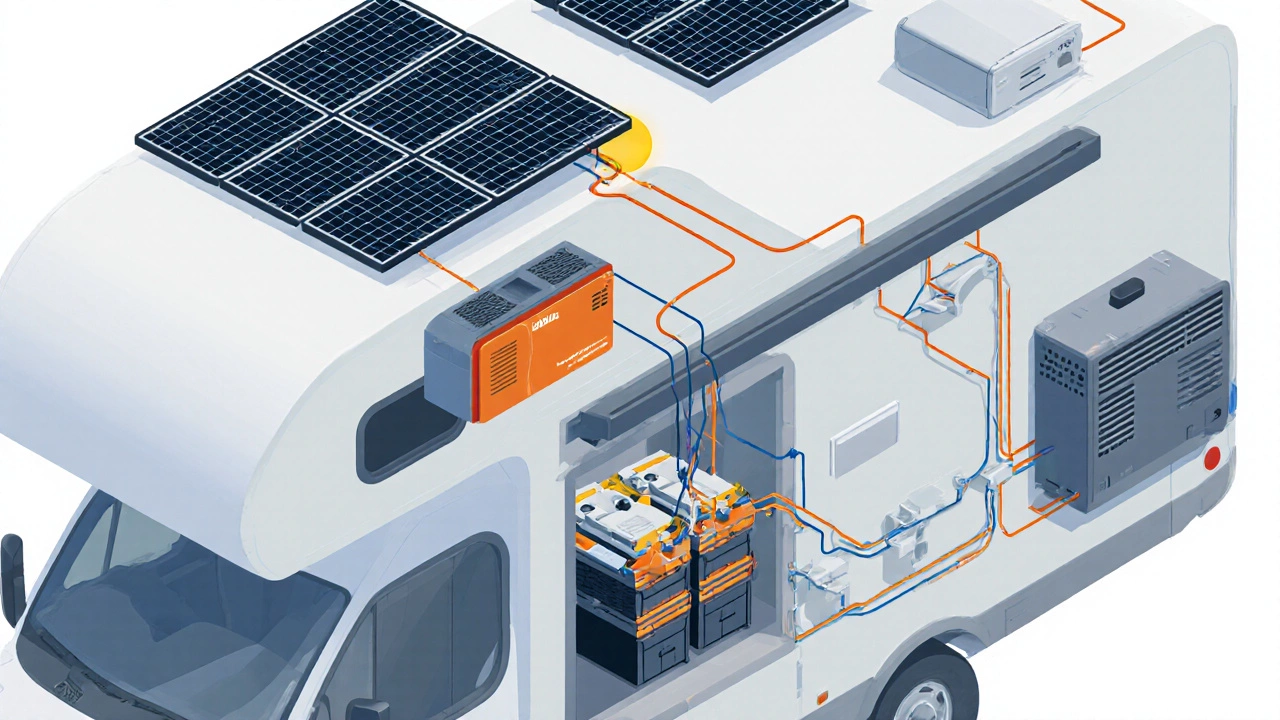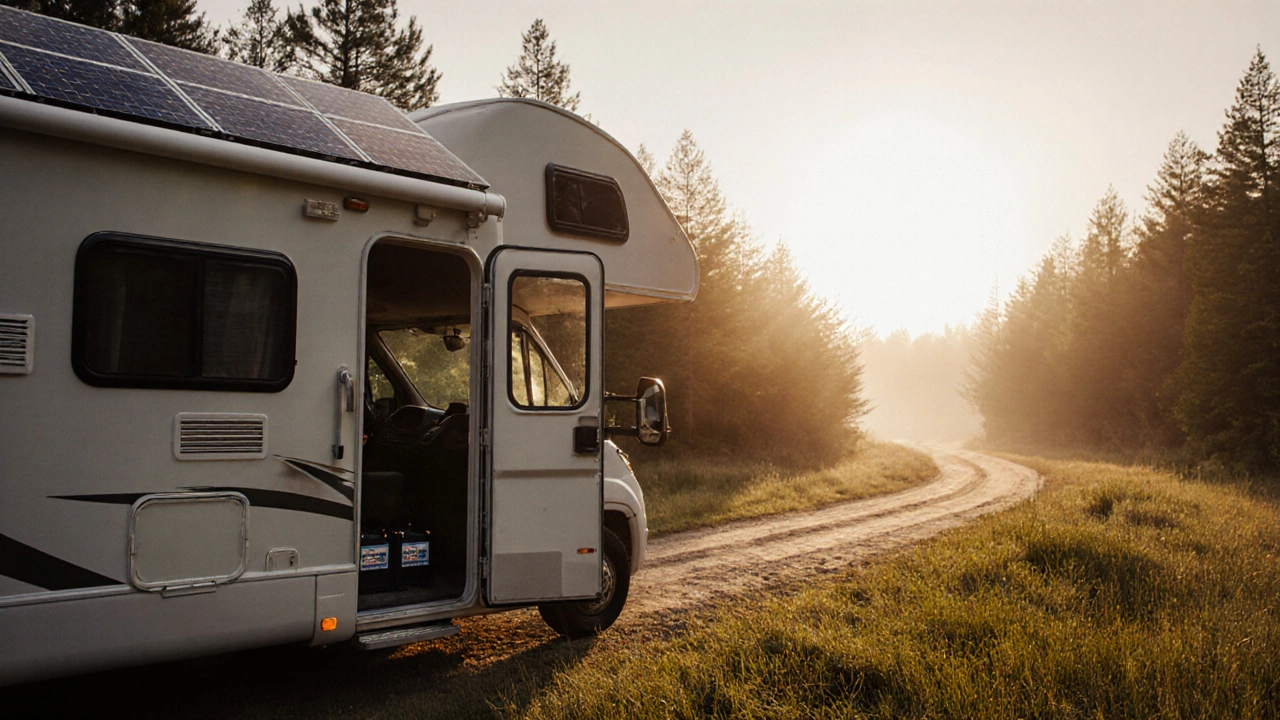Boondocking Power Calculator
Your Power Needs Summary
Daily Load: Wh
Battery Bank Size: Ah (12V)
Solar Array Size: W
Recommendation:
When you park your motorhome in a remote spot with no campsite hookups, the biggest question is: how do you keep the lights on, the fridge humming, and your devices charged? Boondocking electricity isn’t magic-it’s a mix of planning, the right gear, and a bit of know‑how. Below you’ll find the most practical ways to generate, store, and use power while you’re off the grid.
Quick Summary
- Size your daily load before you buy any equipment.
- Solar panels give silent, renewable power; pair them with a good battery bank.
- Portable generators are reliable backup but need fuel and noise considerations.
- When you’re near a campsite, a simple shore‑power plug can charge your system.
- A hybrid setup (solar + generator) offers the best of both worlds.
Understanding Your Power Needs
Before you add a solar panel or a generator, you need to know how much energy you actually use. Most RV owners track their consumption in amp‑hours (Ah) or watt‑hours (Wh). Typical loads include a 12‑V fridge (45Wh), LED lighting (10Wh per fixture), a water pump (30Wh per use), and personal devices (20‑30Wh). Multiply the hourly usage by the number of hours you’ll run each device to get a daily total. This figure tells you the minimum capacity your battery bank must hold and the size of the solar array you’ll need.
RV electrical system is a network of 12‑V DC and 120‑V AC circuits that powers everything inside a motorhome, from lights to appliances. Knowing the split between DC and AC loads helps you decide whether you need an inverter, a larger battery bank, or both.
Solar Panels: The Quietest Solution
Solar panel system is a collection of photovoltaic panels, a charge controller, and wiring that converts sunlight into usable electricity for an RV. The key to a successful solar setup is proper sizing. A 200‑W panel producing an average of 4kWh per day can comfortably cover a 1,500‑Wh daily load when paired with efficient batteries.
Start with a MPPT charge controller is a Maximum Power Point Tracking device that optimizes the power harvested from solar panels, increasing efficiency by up to 30% compared to PWM controllers.. MPPT units also handle higher voltages, letting you use longer wire runs without excessive losses.
Next, choose a Deep‑cycle battery is a rechargeable battery designed to provide a steady amount of current over a long period, ideal for storing solar energy.. Lithium‑ion batteries are lighter and can be discharged deeper (up to 80%), but lead‑acid AGM batteries are cheaper and still reliable for most boondockers.
Finally, an Inverter is a device that converts DC power from your battery bank into 120‑V AC power for household appliances.. Choose a pure‑sine wave inverter if you plan to run sensitive electronics or microwaves; a modified sine wave unit works for simple loads like lights and fans.
Portable Generators: Backup When Sun Goes Down
Portable generator is a fuel‑driven engine that produces AC electricity, often used as a backup power source for RVs. Generators shine when you need a sudden surge-think heating the cabin on a cold night or running a high‑draw appliance like an air conditioner.
When selecting a generator, look at three main specs: running watts, fuel type, and noise level. A 3,500‑W model gives enough headroom for most RVs, while propane‑only units eliminate the need for gasoline storage. Noise is measured in decibels (dB); anything under 65dB is generally acceptable for most campgrounds.
To keep fuel costs low, run the generator only when the battery bank drops below 30% charge. Use an automatic transfer switch (ATS) that senses battery voltage and starts the generator when needed-this prevents over‑discharging your batteries.

Shore Power Hook‑Ups: When You’re Near a Site
If you’re within a few miles of a campsite that offers 30‑A or 50‑A electrical hookups, a simple shore‑power connection can top off your batteries and run AC appliances directly. A Shore power is a grid‑connected electricity source that provides 120‑V AC power through a campsite’s pedestal or cable. Plug the RV’s power cord into the pedestal, then switch your internal power management system to “shore‑charge” mode. Most modern RVs automatically prioritize shore power over the inverter, saving you fuel.
Even if you’re not staying at a campsite, many truck stops and service stations provide 120‑V outlets. A short extension cord and a step‑down transformer can turn that into a quick battery charger in a pinch.
Hybrid Power Setups: Combining Solar and Generator
Relying on a single source can leave you vulnerable-cloudy days limit solar output, and fuel availability may be scarce. A hybrid system lets you use solar as the primary source while the generator fills gaps.
Set your charge controller to charge the battery bank first. When the state's state‑of‑charge (SOC) drops below a preset threshold-typically 40%-the ATS fires up the generator to bring the SOC back up. This approach maximizes renewable energy use and minimizes fuel consumption.
Practical Tips and Common Pitfalls
- Don’t oversize your solar array. More panels mean more weight and cost, but they won’t help if you can’t store the energy.
- Always use proper gauge wiring. Undersized cables cause voltage drop and can overheat.
- Keep batteries in a temperature‑controlled environment. Extreme cold reduces capacity by up to 50%.
- Test your generator before a long trip. A stale fuel tank can cause hard starts.
- Label every circuit in your power management system. Knowing which fuse protects what saves time when a breaker trips.
Checklist for Boondocking Power
- Calculate daily watt‑hour load using a power monitor.
- Select solar panels that can generate at least 1.5× your daily load.
- Choose a battery bank sized for 2-3 days of autonomy.
- Install an MPPT charge controller and match its voltage to your panel array.
- Fit a pure‑sine wave inverter sized for your peak AC demand.
- Pick a portable generator with enough running watts and low dB rating.
- Carry a shore‑power cable and a step‑down transformer for emergency charging.
- Set up an automatic transfer switch to protect batteries from deep discharge.
Frequently Asked Questions
How many watts of solar do I need for a typical boondocking weekend?
Most couples use between 400W and 800W of panels. That range supplies 2,000‑4,000Wh per day, enough for a fridge, lights, water pump, and a few devices. Adjust the size based on your exact load and how many cloudy days you expect.
Can I run an air conditioner on solar alone?
Running a 1,200‑W AC unit continuously would require at least 3,000W of solar panels and a large lithium battery bank (300Ah or more). Most boondockers pair a smaller solar system with a generator for AC use, keeping the AC on only when needed.
What’s the best battery type for boondocking?
Lithium‑ion batteries win on weight, depth of discharge, and cycle life, but they cost more upfront. AGM lead‑acid batteries are a solid budget choice if you keep them above 50% charge and store them in moderate temperatures.
Do I really need an MPPT controller?
Yes, especially if your panel voltage exceeds the battery voltage. MPPT controllers extract up to 30% more power than PWM controllers, making a noticeable difference on cloudy days.
How often should I run my generator while boondocking?
Run it only when your battery SOC drops below 30% or when you have a high‑draw load that the solar array can’t meet. A weekly 30‑minute run‑time is enough to keep the engine lubricated and the battery topped up.
